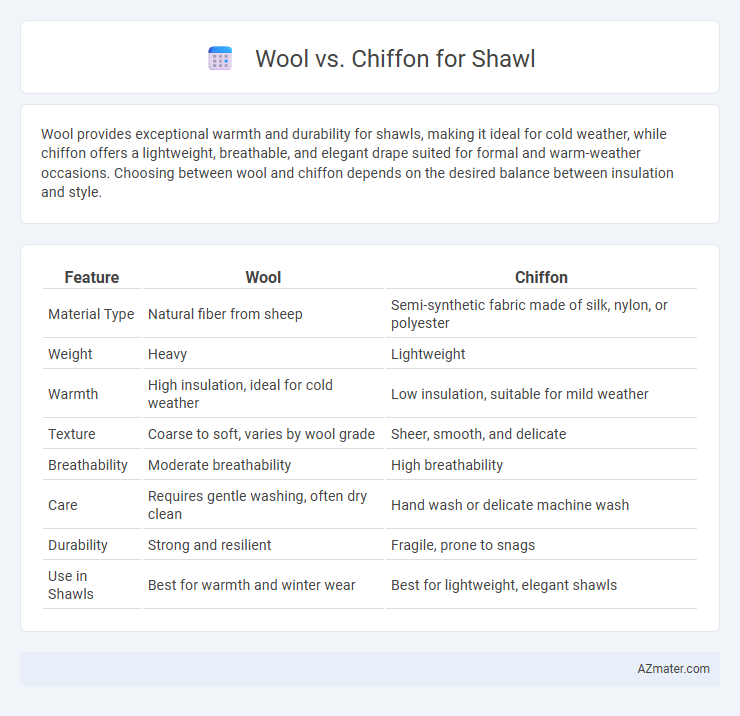Wool provides exceptional warmth and durability for shawls, making it ideal for cold weather, while chiffon offers a lightweight, breathable, and elegant drape suited for formal and warm-weather occasions. Choosing between wool and chiffon depends on the desired balance between insulation and style.
Table of Comparison
| Feature | Wool | Chiffon |
|---|---|---|
| Material Type | Natural fiber from sheep | Semi-synthetic fabric made of silk, nylon, or polyester |
| Weight | Heavy | Lightweight |
| Warmth | High insulation, ideal for cold weather | Low insulation, suitable for mild weather |
| Texture | Coarse to soft, varies by wool grade | Sheer, smooth, and delicate |
| Breathability | Moderate breathability | High breathability |
| Care | Requires gentle washing, often dry clean | Hand wash or delicate machine wash |
| Durability | Strong and resilient | Fragile, prone to snags |
| Use in Shawls | Best for warmth and winter wear | Best for lightweight, elegant shawls |
Introduction: Wool vs Chiffon Shawls
Wool shawls offer unmatched warmth, durability, and natural insulation, making them ideal for cold weather and outdoor use. Chiffon shawls provide lightweight, breathable comfort with a sheer and delicate texture, perfect for elegant occasions and layering. Choosing between wool and chiffon shawls depends on the desired balance between warmth, texture, and style.
Texture and Feel: Comfort Comparison
Wool shawls provide a rich, warm texture that feels cozy and insulating, ideal for cold weather comfort. Chiffon shawls offer a lightweight, smooth texture with a soft, airy feel that enhances breathability and ease of movement. The comfort of wool comes from its natural insulation and slight elasticity, while chiffon delivers a delicate, cool touch suited for mild temperatures.
Warmth and Insulation Properties
Wool shawls offer superior warmth and insulation due to their natural crimped fibers, which trap heat effectively, making them ideal for cold weather. Chiffon shawls, made from lightweight, sheer fabrics like silk or polyester, provide minimal insulation and are better suited for decorative or mild climate use. Wool's ability to retain heat even when damp enhances its performance in chilly conditions compared to chiffon.
Breathability and Lightweight Features
Wool shawls provide excellent warmth but are generally less breathable and heavier compared to chiffon, which is renowned for its exceptional lightweight and airy properties. Chiffon allows better air circulation, making it ideal for warmer climates or layering without adding bulk. The moisture-wicking nature of wool enhances insulation but may cause heavier feel, whereas chiffon's thin, sheer fabric ensures maximum comfort through breathability.
Style Versatility: Formal vs Casual Wear
Wool shawls offer warmth and a structured appearance, making them ideal for formal occasions and cooler weather events. Chiffon shawls provide a lightweight, sheer texture that enhances casual and semi-formal outfits with an elegant and airy feel. Choosing between wool and chiffon depends on the desired style versatility, with wool suited for classic, sophisticated looks and chiffon perfect for breezy, relaxed ensembles.
Seasonal Suitability: Wool or Chiffon?
Wool shawls provide excellent warmth and insulation, making them ideal for cold winter months or chilly autumn evenings. Chiffon shawls, being lightweight and breathable, are perfectly suited for spring and summer seasons, offering comfort without overheating. Choosing between wool and chiffon depends on whether thermal retention or ventilation is prioritized for seasonal wear.
Maintenance and Care Requirements
Wool shawls require careful washing in cold water with mild detergent to prevent shrinking and maintain softness, while chiffon shawls demand gentle hand washing or dry cleaning to avoid fabric distortion or damage. Wool fibers benefit from occasional airing and protection from moths, whereas chiffon needs to be stored flat or hung to prevent wrinkles and delicate tearing. Both materials require careful handling, but chiffon's lightweight, sheer texture makes it more susceptible to wear and requires more frequent, delicate maintenance.
Durability and Longevity
Wool shawls offer superior durability and longevity due to their natural resilience and ability to withstand wear and tear over time. Chiffon shawls, while lightweight and elegant, are more prone to snags and delicate damage, making them less durable for frequent use. Choosing wool ensures a shawl that maintains its integrity and appearance through extended wear and seasonal changes.
Price Range and Value for Money
Wool shawls generally come with a higher price range, typically between $50 to $300, reflecting their warmth, durability, and natural fiber quality. Chiffon shawls are more affordable, often priced from $15 to $80, offering lightweight elegance but less insulation. Wool provides better long-term value for money due to its longevity and thermal properties, while chiffon shawls are budget-friendly options for stylish, breathable wear.
Conclusion: Choosing the Best Shawl Fabric
Wool shawls provide superior warmth and durability, making them ideal for colder climates and long-term use. Chiffon shawls offer lightweight elegance and breathability, perfect for formal events or mild weather. Selecting the best shawl fabric depends on desired comfort, occasion, and climate, with wool excelling in insulation and chiffon in style.

Infographic: Wool vs Chiffon for Shawl
 azmater.com
azmater.com